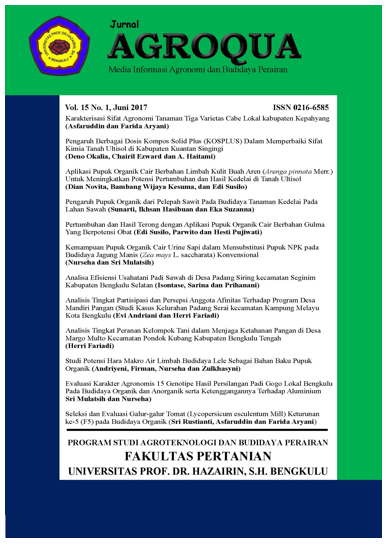LIMBAH TERNAK KELINCI SEBAGAI BAHAN BAKU PUPUK ORGANIK POTENSIAL
DOI:
https://doi.org/10.32663/ja.v16i2.506Keywords:
organic fertilizer, animal waste rabbits, raw materials, nutrients, go organicAbstract
Many sources of raw materials which allegedly can enrich the nutrient content in the organic fertilizer. The weakness of organic fertilizer for this is the low level of nutrients contained in them.This study aims to determine the nutrient content contained in various combinations of organic fertilizer raw materials with rabbit animal waste as the main raw material.This study aims to determine the nutrient content in various combinations of organic fertilizer raw materials with rabbit animal waste as the main raw material. The experiment used a completely randomized design with raw materials as treatments, Livestock Waste Rabbit (LTK), Cow Manure (PKS) and Abu Straw Rice (AJP). Such treatment: B1 = LTK; B2 = LTK: PKS = 2: 1; B3 = LTK: AJP = 3: 1; B4 = LTK: PKS: AJP = 6: 2: 1; B5 = LTK: PKS: AJP = 5: 2: 1; B6 = LTK: PKS: AJP = 4: 2: 1; B7 = LTK: PKS: AJP = 3: 2: 1; B8 = LTK: PKS: AJP = 2: 2: 1; B9 = LTK: PKS: AJP = 1: 2: 1. The research concluded (a) Organic fertilizers are made from various materials raw has fulfilled SNI 19-7030-2004 about the specifications of Organic Waste Compost. (B) A combination of organic fertilizer raw materials significantly affect the nutrient content of manure. (C) Organic fertilizers expectations are: (a) Raw materials of animal wastes rabbit (LTK), (b) LTK: PKS: AJP = 6: 2: 1, (c) LTK: PKS: AJP = 2: 2: 1 and (d) LTK: PKS: AJP = 1: 2: 1.
References
Downloads
Published
Issue
Section
License
Authors who publish with this journal agree to the following terms:
- Authors grant the journal right of first publication with the work simultaneously licensed under a Creative Commons Attribution 4.0 Internasional (CC BY 4.0) Licence that allows others to use and share the work with an acknowledgment of the work's authorship and initial publication in this journal.
- The author(s) still hold the copyright of his/her/their work and retain publishing rights without restrictions such as (but not limited to) patent right, lecture, book and reproduce the article for own purposes.
















